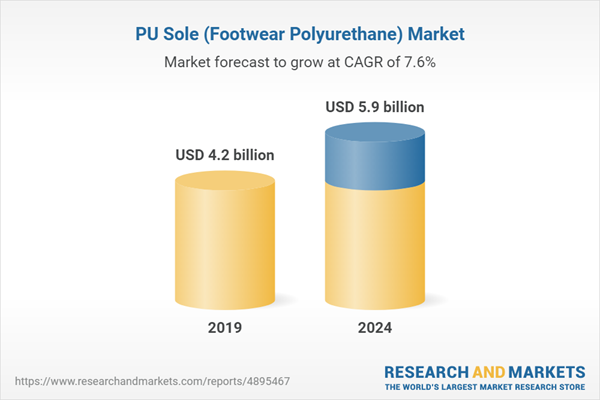The global PU sole (footwear polyurethane) market is projected to witness a CAGR of 7.6% during the forecast period.
Casuals-the largest application in the overall PU sole (footwear polyurethane) market.
The casuals segment is projected to be the largest footwear in the overall PU sole (footwear polyurethane) market. The large market size for this segment is attributed to consumer preference for casuals in some countries, including China and India. The demand for PU sole is growing because casual footwear can be used on a daily basis and it also provides a wide range of performance in outdoor activities. Loafers, sneakers, and flat shoes are some of the casual footwear in the market.
Methylene diphenyl diisocyanate (MDI) raw material is the fastest-growing segment in the overall PU sole (footwear polyurethane) market.
Methylene diphenyl diisocyanate (MDI) is a raw material for PU sole (footwear polyurethane). MDI is the most widely-used aromatic diisocyanate in PU sole (footwear polyurethane), which primarily exists in three isomers, namely 2,2'- MDI, 2,4'-MDI, and 4,4'-MDI. 4,4’-MDI isomer is used in shoe sole formulation. In order to make polyurethane for footwear, MDI is reacted with polyols in the presence of other additives. MDI-based polyurethanes have applications in compact outsoles and unit soles. The properties of MDI, such as high degree of stiffness and resilience is expected to drive the market for this segment.
APAC is the largest and the fastest-growing market of PU sole (footwear polyurethane).
APAC is projected to be the largest and the fastest-growing market for PU sole (footwear polyurethane). The high growth rate of the market in the region is due to the increasing production of footwear from countries such as China, India, Indonesia, and Vietnam. China is expected to be the largest market for PU sole (footwear polyurethane) in APAC. Indonesia is expected to be the fastest-growing market in the region as well as globally. The regional demand is expected to increase during the forecast period, owing to the growing population and consumer spending. China is the leading manufacturer and consumer of footwear in APAC. The high demand for sports and casual footwear is expected to drive the demand for PU sole (footwear polyurethane) in the region.
Extensive primary interviews were conducted to determine and verify the market size for several segments and subsegments and information gathered through secondary research.
The breakup of primary interviews is given below.
- By Company Type - Tier 1 – 20%, Tier 2 – 55%, and Tier 3 – 25%
- By Designation - C level – 50%, Director level – 25%, and Others – 25%
- By Region - North America – 60%, Europe – 20%, APAC – 10%, the Middle East & Africa – 5%, and South America – 5%.
The leading players in the global PU sole (footwear polyurethane) market include BASF SE (Germany), Covestro (Germany), DuPont (US), Huntsman (US), Wanhua Chemical Group (China), Coim Group (Italy), Lubrizol (US), Lanxess (Germany), Manali Petrochemical (India), and INOAC (Japan).
Research Coverage:
This research report categorizes the global PU sole (footwear polyurethane) market on the basis of application, raw material, and region. The report includes detailed information regarding the major factors influencing the growth of the market, such as drivers, restraints, challenges, and opportunities. The detailed analysis of key market players provides insights into business overviews, products & services, key strategies, investments & expansions, mergers & acquisitions, and recent developments in the market.
Reasons to Buy the Report:
- This report segments the global PU sole (footwear polyurethane) market comprehensively and provides the closest approximations of sizes for the overall market and subsegments across various verticals and regions.
- The report will help stakeholders understand the pulse of the market and provide them with information on the key market drivers, restraints, challenges, and opportunities.
- This report will help stakeholders understand the major competitors and gain insights to enhance their positions in the business. The competitive landscape section includes expansions, new product developments, and mergers & acquisitions undertaken in the market.
Table of Contents
Samples

LOADING...
Companies Mentioned
- Asahi Kasei Corporation
- BASF
- Cellular Mouldings
- COIM
- Covestro
- Dow Inc
- ERA Polymers
- Eurofoam Group
- Headway Group
- Huntsman Corporation
- INOAC Corporation
- Kasodur
- LANXESS
- Lubrizol
- Manali Petrochemical
- Perstorp
- Rogers Corporation
- Trelleborg
- VCM Polyurethanes
- Wanhua Chemical Company
Methodology

LOADING...
Table Information
| Report Attribute | Details |
|---|---|
| No. of Pages | 127 |
| Published | December 2019 |
| Forecast Period | 2019 - 2024 |
| Estimated Market Value ( USD | $ 4.2 billion |
| Forecasted Market Value ( USD | $ 5.9 billion |
| Compound Annual Growth Rate | 7.0% |
| Regions Covered | Global |
| No. of Companies Mentioned | 20 |









